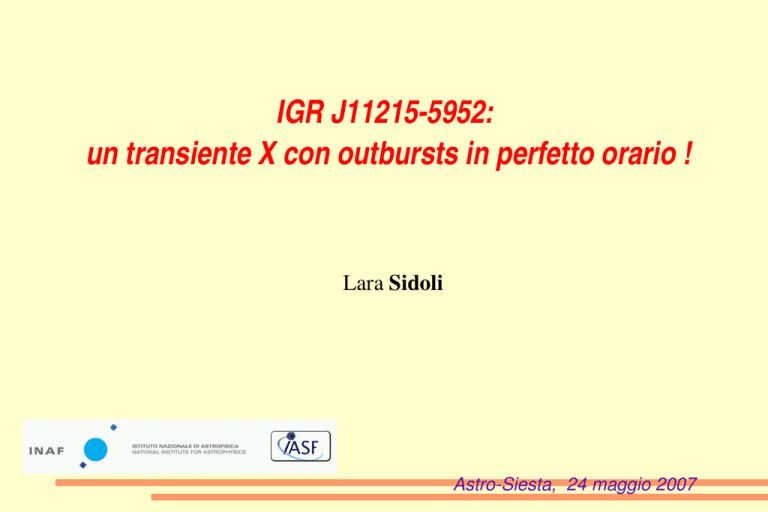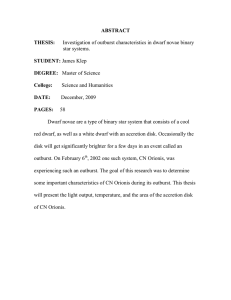IGR J112155952: un transiente X con outbursts in
advertisement

IGR J11215­5952: un transiente X con outbursts in perfetto orario ! Lara Sidoli Astro­Siesta, 24 maggio 2007 Sources detected with ISGRI during the first 4 years of observations from Bodaghee et al., 2007, astro­ph/0703043 ~ 10% of the new IGRs are Supergiant Fast X­ray Transients SFXTs are a new class of sources discovered with INTEGRAL thanks to the Galactic Plane monitoring INTEGRAL discoveries and observations Supergiant Fast X­ray Transients IGR J17391­3021/XTE J1739­302 ISGRI SWs (~2 ks) image sequence (20­30 keV) flux at peak=254 mCrab ● OUTBURST DURATION: ~ few hours, less than a day ● RECURRENT OUTBURSTS ● HARD AND HIGHLY ABSORBED X­RAY SPECTRUM – ● reminiscent of an X­ray pulsar OPTICAL COUNTERPART: highly reddened O B supergiants from Sguera et al. 2005 Another interesting property of SFXTs: L outburst / L quiesc. ~ 1000­10000 (from ASCA archival, or XMM or Chandra obs) but only from few sources! Flux (20­40 keV) at the peak of the outburst, together with the “quiescent” level quiescent level measured well far away from the outbursts 1997, Aug, XTE obs 2004, Aug, ISGRI obs SFXTs properties: absorbing column density from X­ray spectra NH – NH Gal (1E22 cm­2) Total NH Galactic (1E22 cm­2) towards the sources SFXTs properties: X­ray luminosity during the short flares Supergiant Fast X­ray Transients: proposed interpretations (I) ● Outbursts produced by short ejections from the donor stars in XRBs? or clumpy winds? (in 't Zand 2005) Supergiant Fast X­ray Transients: proposed interpretations (II) ● A new kind of supergiant HMXRBs in wide eccentric orbits? (wider than “normal” supergiants HMXRBs, like Vela X­1, in nearly circular orbits) also to explain the large Lmax / Lmin (Negueruela et al. 2005) IGR J11215­5952: a unique SFXT Fast transient discovered on April 22, 2005 (Lubinski et al. 2005) The companion is a B­type Supergiant: HD 306414 (Negueruela et al. 2005; Masetti et al. 2006) The INTEGRAL lightcurve shows a periodicity of ~ 330 days in the recurrence of the outbursts (Sidoli, Paizis & Mereghetti, 2006, A&A, 450, L9; astro­ph/0603081). ~ 330 days ! 1st outburst 3­4 July 2003 ~ 330 days ! 2nd outburst 26­27 May 2004 3rd outburst 22 Apr 2005 ISGRI lightcurves (17­40 keV) 330 days = likely orbital period 4th outburst lightcurve (Smith et al. 2006, ATel 766 and ATel 773) from http://scipp.ucsc.edu/~dsmith/atel/atel0306/ IGR J11215­5952 is a slow X­ray pulsator XTE/PCA pointings revealed a spin period of the neutron star of Pspin=186.8 +/­ 0.3 (Swank et al. 2007) Porb=329 days seems to suggest that outbursts in SFXTs might be related to wide eccentric orbits and not to clumpy winds The periodic nature of the outbursts from IGR J11215­5952 allowed us to plan & perform for the first time a sensitive and complete monitoring of the entire outburst from a SFXT, during the latest outburst, expected on 2007, 9th February with Swift/XRT Results in Romano, Sidoli, Mangano, Mereghetti & Cusumano , 2007 (A&A in press; astro­ph/0704.0543) Final lightcurve from Swift / XRT observations of IGR J11215­5952 9th February 2007 Romano et al. 2007 Note that INTEGRAL would have seen ONLY the bright “orange” region of the lightcurve, lasting less than 1 day and composed of several ``short flares” 9th February 2007 Close­up view of the brightest part of the outburst (9th Feb) How to explain the outburst? The recurrence time of 329 days is the underlying clock of the phoenomenon, which can be interpreted in a natural way as the orbital period of the binary system Model of accretion from a spherical homogeneous wind in an eccentric orbit around the HD star Simulation of the radiatively driven outflow from a rotating hot star with a dipole magnetic field Log (wind density) from Ud­Doula, Townsend & Owocki, 2006, ApJ, 640, L191 The proposed geometry to explain the short SFXT outbursts: OB supergiant ns The thin equatorial disk of the B­supergiant is inclined with respect to the orbital plane The star has also a polar wind with higher velocity and lower mass loss rate (~0.01 * Mass loss rate in the disk) thus, in order to explain the low X­ray emission level out of the outburst, we need anyway a not circular orbit Sidoli et al., 2007, in preparation The thickness “h” of the densest region of this disk orbital plane “h” can be estimated from the duration of the outburst: the duration t of the brightest part of the outburst is t ~ 1 day, the ns velocity near periatron is roughly vns ~ 100­200 km/s thus: h ~ 8E11 – 1.7 E12 cm (0.3­0.6 Ropt, if Ropt ~ 40 Rsun) h The thickness “h” of the densest region of the disk orbital plane “h” can be estimated from the duration of the outburst: the duration t of the brightest part of the outburst is t ~ 1 day, the ns velocity near periatron is roughly vns ~ 100­200 km/s thus: h ~ 8E11 – 1.7 E12 cm (0.3­0.6 Ropt, if Ropt ~ 40 Rsun) Nh galactic < 0.8 E 22 cm­2; Nh from X­ray spectra ~1­2 * 1E22 cm­2 Assuming about 1E22 cm­2 is local and mainly due to the supergiant disk, a rough estimate of the ρ density of the supergiant disk is: Nh*mH / h = ρ ∼ 1Ε−14 cm−3 h variable wind density along the orbit “disk” wind “polar” wind Example of the model of wind accretion Conclusions INTEGRAL observations opened a new view on High Mass X­ray Binaries ● The new class of SFXTs has been discovered ● The SFXT IGRJ11215­5952 is a key system to understand this new class of X­ray sources ● We proposed a new hypothesis to explain the properties of the SFXTs, where the supergiant has an equatorial component of the wind, besides the “standard” “polar” high velocity wind. The enhanced accretion rate when the neutron star cross this disk produce the short duration X­ ray outburst ● Gr az ie !! !




